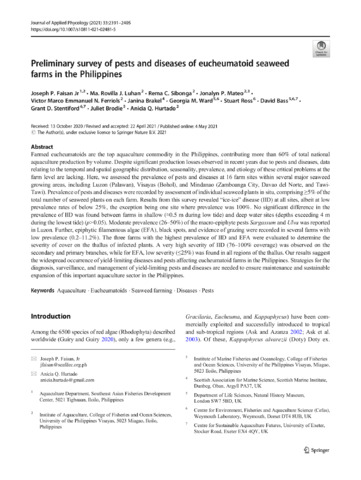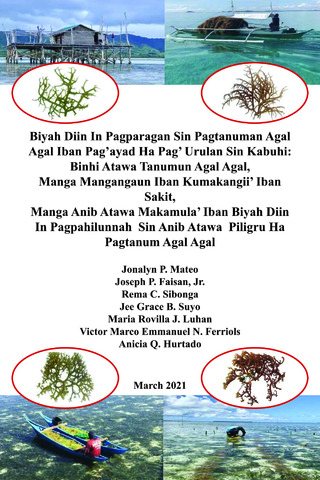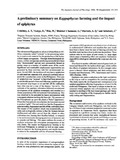| dc.contributor.author | Borlongan, Iris Ann G. | |
| dc.contributor.author | Luhan, Maria Rovilla J. | |
| dc.contributor.author | Padilla, Philip Ian P. | |
| dc.contributor.author | Hurtado, Anicia Q. | |
| dc.date.accessioned | 2016-10-06T06:36:40Z | |
| dc.date.available | 2016-10-06T06:36:40Z | |
| dc.date.issued | 2016 | |
| dc.identifier.citation | Borlongan, I. A. G., Luhan, M. R. J., Padilla, P. I. P., & Hurtado, A. Q. (2016). Photosynthetic responses of ‘Neosiphonia sp. epiphyte-infected’ and healthy Kappaphycus alvarezii (Rhodophyta) to irradiance, salinity and pH variations. Journal of Applied Phycology, 28(5), 2891-2902. | en |
| dc.identifier.issn | 0921-8971 | |
| dc.identifier.uri | http://hdl.handle.net/10862/3076 | |
| dc.description.abstract | Understanding the physiological condition of seaweeds as influenced by biotic and abiotic stress is vital from the perspective of massive expansion and sustainability of seaweed-based industries. The photosynthetic responses ofNeosiphonia sp. epiphyte-infected (INF) and healthy (HEA) Kappaphycus alvarezii under various combinations of irradiance, salinity and pH were studied using photosynthesis-irradiance (P-E) curves. Measurements of algal photosynthetic rates, expressed in terms of amount of oxygen production per fresh weight biomass per unit time (mg O2 g−1 FW h−1), were carried out using the light-dark bottle technique. Neosiphonia-infected K. alvarezii (INF) had lower photosynthetic rates than healthy ones (HEA). Similarities (p > 0.05) in light-saturated photosynthesis rates (Pmax) and significant differences (p < 0.05) in initial slope of curve (α) between INF and HEAK. alvarezii suggest that both samples are adapted to similar light conditions and differs only on photosynthetic efficiency. Low Pmax (0.7–2.0 mg O2 g−1 FW h−1) and high initial saturation irradiances (Ek = 90–519 μmol photons m−2 s−1) of INF seaweeds resulted to their low photosynthetic efficiency (α = 0.002–0.010). Such decline in α is attributed to the epiphyte, as Neosiphonia sp. covered almost the entire surface of K. alvarezii. An increase in chlorophyll-a (35–42.1 vs. 27.7–31.5 μg g−1 FW, HEA) and phycobilin (1.96–2.39 vs. 1.16–1.58 mg g−1 FW, HEA) contents was also observed in INF samples, suggesting acclimation to low-irradiance conditions, as a result of competition for light between the epiphyte and host. Both INF and HEA K. alvarezii also exhibited broad photosynthetic tolerance to short-term changes in irradiance, with no photoinhibition at the highest irradiance of 850 μmol photons m−2 s−1. K. alvarezii had a euryhaline photosynthetic response, with optimum salinity of 35 psu. Photosynthetic rates increased with decreasing pH, revealing K. alvarezii’s ability to modify its photosynthetic affinity for acidic seawater conditions; yet, their underlying mechanism of response to pH shifts still need to be further examined. | en |
| dc.description.sponsorship | This research was funded in part by the University of the Philippines-Visayas (UPV) through the Office of the Vice-Chancellor for Research and Extension and Southeast Asian Fisheries Development Center Aquaculture Department. This research was the thesis submitted by the first author in fulfilment of her degree in Master of Science in Biology at UPV. | en |
| dc.language.iso | en | en |
| dc.publisher | Springer Verlag | en |
| dc.subject | Kappaphycus alvarezii | en |
| dc.subject | Seaweed epiphytes | en |
| dc.subject | Seaweed stress | en |
| dc.title | Photosynthetic responses of ‘Neosiphonia sp. epiphyte-infected’ and healthy Kappaphycus alvarezii (Rhodophyta) to irradiance, salinity and pH variations | en |
| dc.type | Article | en |
| dc.citation.volume | 28 | |
| dc.citation.issue | 5 | |
| dc.citation.spage | 2891 | |
| dc.citation.epage | 2902 | |
| dc.citation.journalTitle | Journal of Applied Phycology | en |
| dc.subject.asfa | photosynthesis | en |
| dc.subject.asfa | seaweed culture | en |
| dc.subject.asfa | seaweed cultivation | en |
| dc.subject.asfa | epiphytes | en |
| dc.identifier.essn | 1573-5176 | |
| dc.identifier.doi | 10.1007/s10811-016-0833-4 | |
| dc.subject.scientificName | Neosiphonia | en |



